2MASS Galaxy Redshift Catalog (XSCz)
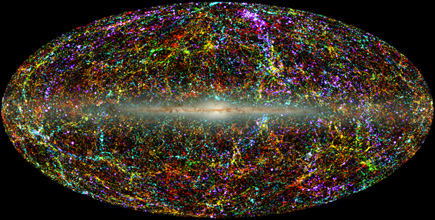
2MASS Galaxy Redshift Catalog (XSCz) |

|
| To accomodate the media that is traditionally used to view astronomical maps, the XSCz is displayed in two-dimensions (X-Y) using an equal-area projection (aka "aitoff projection"), and to convey the third dimension (of distance, or z) the map is color-tagged by each galaxy redshift. The result is shown here. Although this map conveys a tremendous amount of information, it is limited by the 2-D projection, squashing the third dimension into a flat visual. The full XSCz, with X-Y-Z position and luminosity, can only be experienced with 3-D rendering software, such as Partiview, a freely available program from the NCSA and Hayden Planetarium Digital Universe. Partiview expertly allows the user to fly through the XSCz data universe. In this section, we present some "snapshots" from 4-D rendering of the XSCz, in which 3-D positions are joined with the 4th dimension of luminosity. |
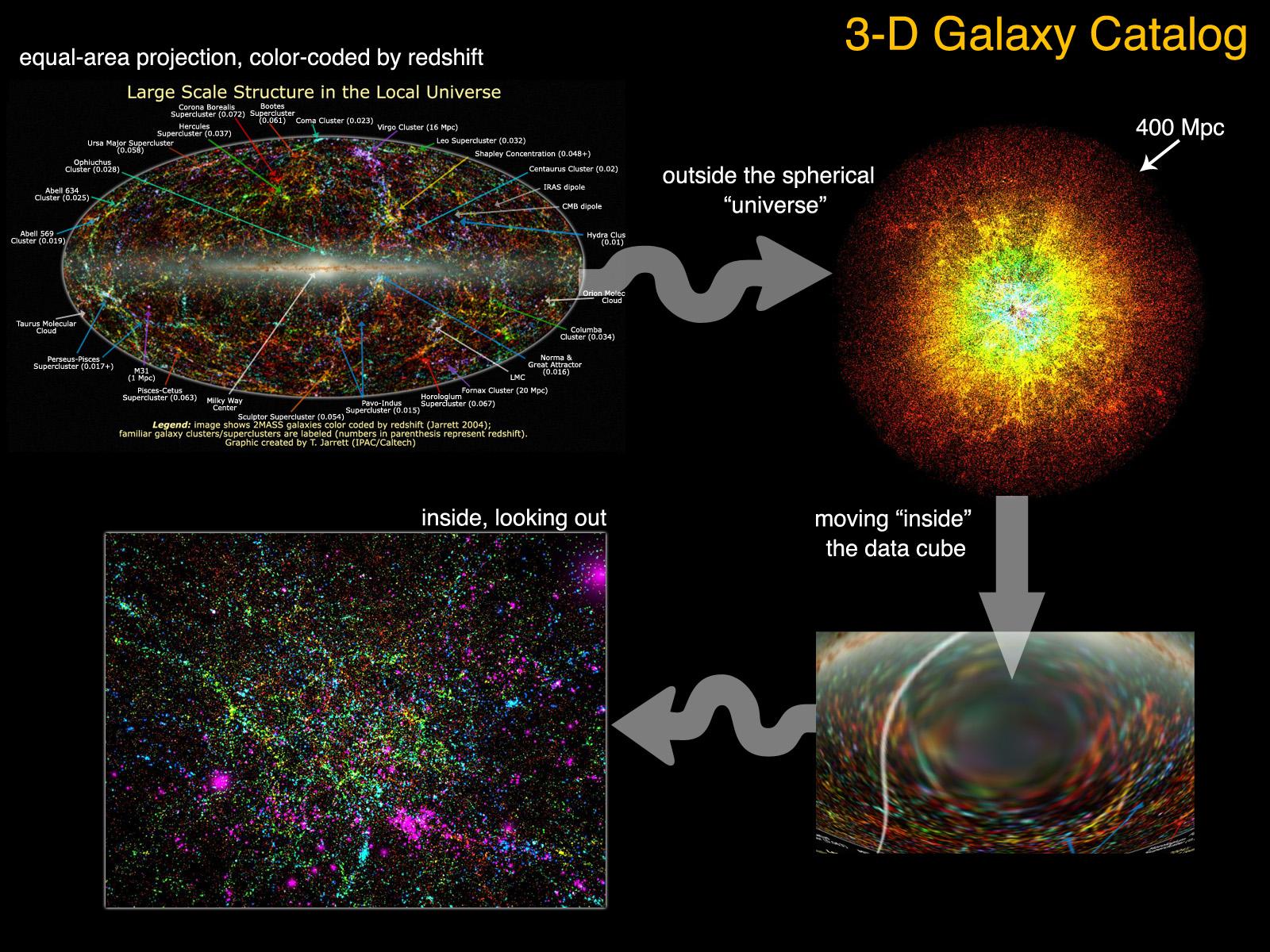
|
| The XSCz sphere is sliced up into redshift "shells", each tagged with it's own color (to help distinguish between redshift shells), while each point (galaxy) is given a brightness that reflects its true luminosity. What is seen are galaxies distributed in coherent structures that extend dozens of Mpc in size, dense clusters and field galaxies. At lower redshifts where radial velocities dominate the sample (z < 0.04), the structures are most easily discerned. At higher redshifts, the structures become 'blurred' with the intrinsic uncertainties (~30%) in the photometric redshifts. Two types of artifact "features" are also present in the data: (1) artifical voids due to obscuration from the Milky Way, particularly near the Galactic Center, and (2) radial velocity "fingers of god" structures that are associated with galaxy clusters (or any coherent structure with large radial velocity dispersions). For well-defined clusters (e.g., Virgo), the "fingers" have been removed -- that is, modified to more accurately reflect the radial gaussian distribution of galaxy clusters. |
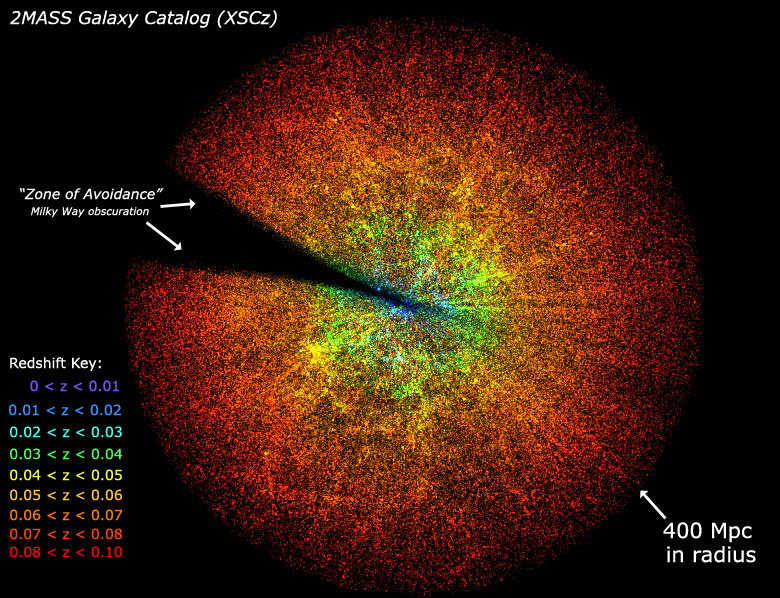
|
|
0 < z < 0.01 ; 0 to 3000 km/s ; 0 to 41 Mpc Local Supercluster, including the Sun, Local Group of Galaxies (e.g., M31) and the Virgo Galaxy Cluster (D = 16 Mpc). This volume contains ~6,600 2MASS galaxies in 296,000 Mpc3. |
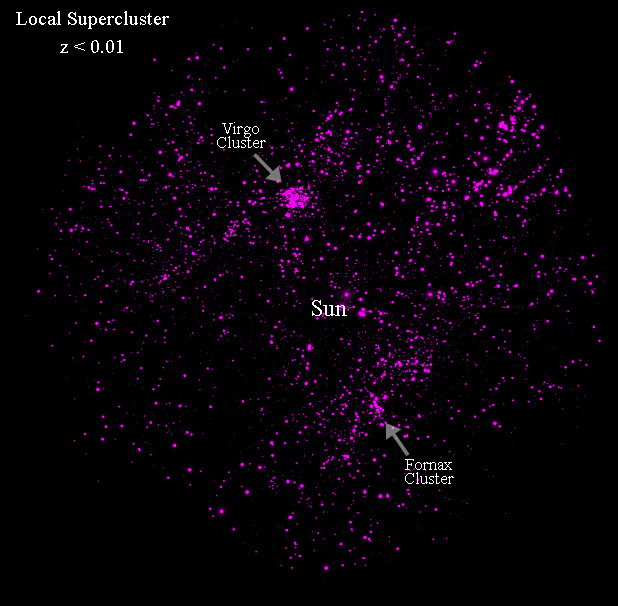
|
|
0.01 < z < 0.02 ; 3000 to 6000 km/s ; 41 to 82 Mpc Several large superclusters are seen in this shell, including the magnificent Perseus-Pisces string of clusters, the Hydra-Centaurus complex that extends behind the disk of the Milky Way joining with Abell 3627 and the Pavi-Indus supercluster. Hydra-Cen-Abell3627, also known as the "Great Attractor", is bisected by the dark 'gap' in the galaxy distribution -- obscuration from the Milky Way and the Galactic Center (traditionally known as the Zone of Avoidance because it is a nuisance to work through the Milky Way), that imparts incompleteness in the XSCz and every other survey that attempts to work in the ZoA. Another parti-view of Abell 3627, the "Norma Cluster" is shown here. This shell volume contains ~20,000 2MASS galaxies in 2 million Mpc3. |
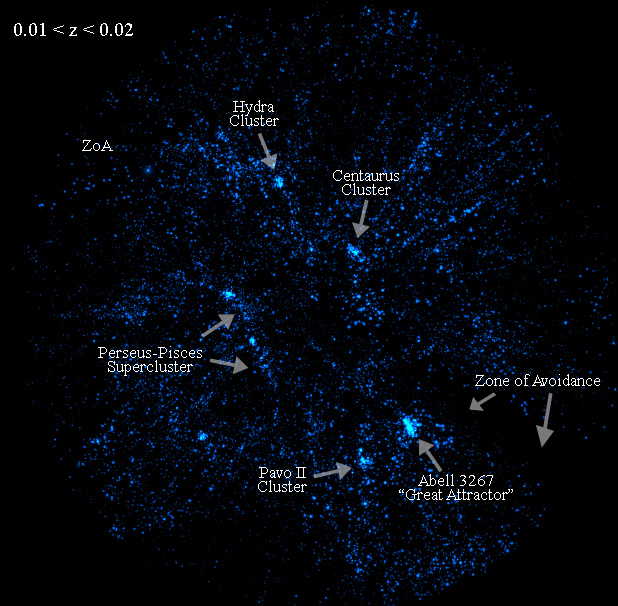
|
|
0.02 < z < 0.03 ; 6000 to 9000 km/s ; 82 to 122 Mpc The famous Huchra & Gellar Great Wall is found in this shell. The Wall is anchored by the massive galaxy cluster known as Coma, located near the pole of the northern hemisphere. Closer to the Galactic Plane and the Center of the Milky Way is the heavily obscured Ophiuchus Galaxy Cluster. Due to significant Galactic obscuration, this cluster is only partially revealed by 2MASS. This shell volume contains ~35,000 2MASS galaxies in 5 million Mpc3. |
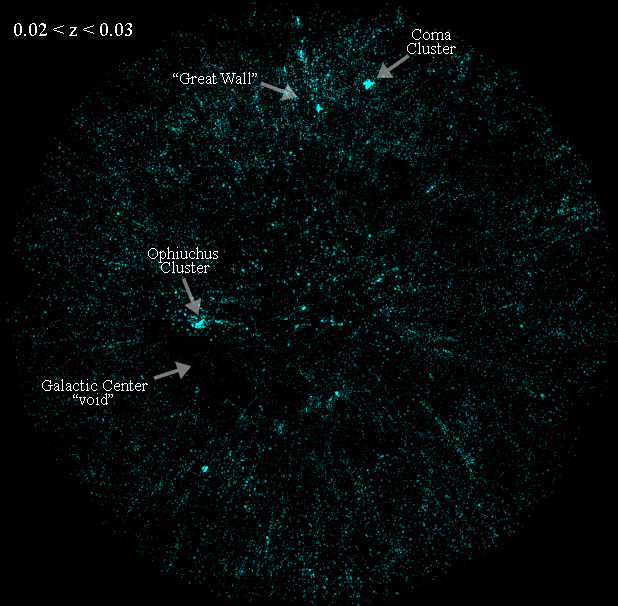
|
|
0.03 < z < 0.04 ; 9,000 to 12,000 km/s ; 122 to 162 Mpc The mighty Hercules Supercluster is the premier structure found in this shell. Hercules and it's associated clusters form an intricate string of clusters that must be viewed in 3-D to be fully appreciated (the snapshot provided here is not worthy). This shell volume contains ~56,000 2MASS galaxies in 10 million Mpc3. |
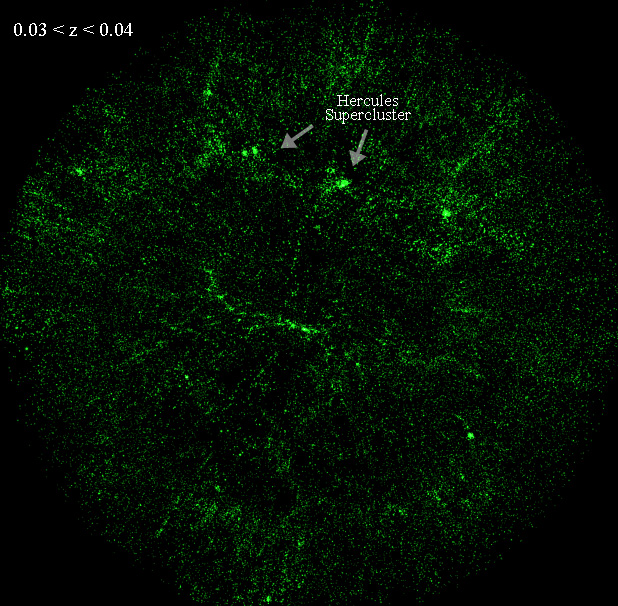
|
|
0.04 < z < 0.05 ; 12,000 to 15,000 km/s ; 162 to 201 Mpc At the other end of the "Local Universe", the Shapley Concentration is the true "Great Attractor", representing the largest mass density 'attractor' in the local universe. Now reaching depths where 2MASS is only sensitive to the more luminous galaxies (i.e., earlty-type ellipticals) in clusters and the field. This shell volume contains ~71,000 2MASS galaxies in 16 million Mpc3. |
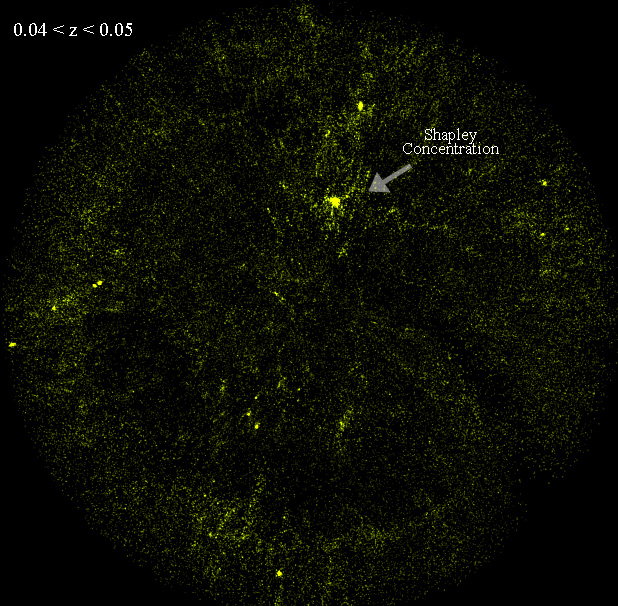
|
|
0.05 < z < 0.06 ; 15,000 to 18,000 km/s ; 201 to 239 Mpc At these distances, radial velocity measurements are becoming rare (~30% of total in shell), so the XSCz is relying on JHK photometric redshifts; consequenty, the ability to discern real physical structures is diminishing. One of the few that can be recognized is the Sculpter Supercluster. This shell volume contains ~100,000 2MASS galaxies in 23 million Mpc3. |
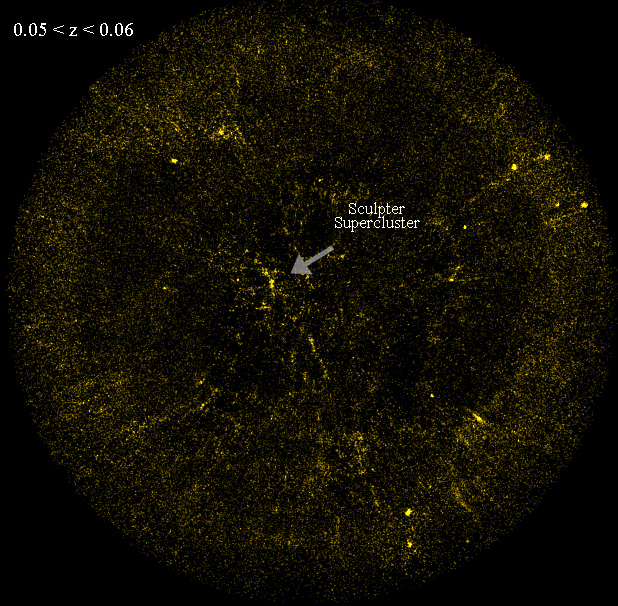
|
|
0.06 < z < 0.07 ; 18,000 to 21,000 km/s ; 239 to 277 Mpc The Horologium Supercluster is located in this shell; the volume contains ~120,000 2MASS galaxies in 32 million Mpc3. |
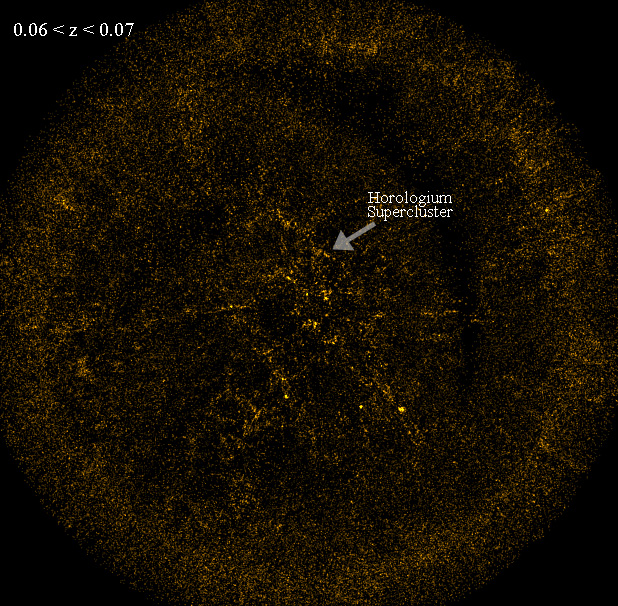
|
|
0.07 < z < 0.08 ; 21,000 to 24,000 km/s ; 277 to 315 Mpc In the northern hemisphere, the Corona Borealis structure dominates the shell; the volume contains ~132,000 2MASS galaxies in 41 million Mpc3. |
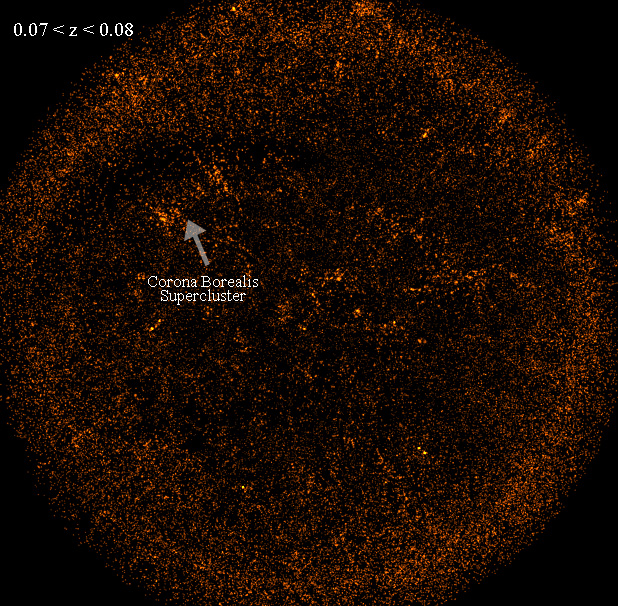
|
|
0.08 < z < 0.09 ; 24,000 to 27,000 km/s ; 315 to 351 Mpc The distribution looks smooth because of the uncertainties in the photometric redshifts render the structures less defined. The shell volume contains ~126,000 2MASS galaxies in 51 million Mpc3. |
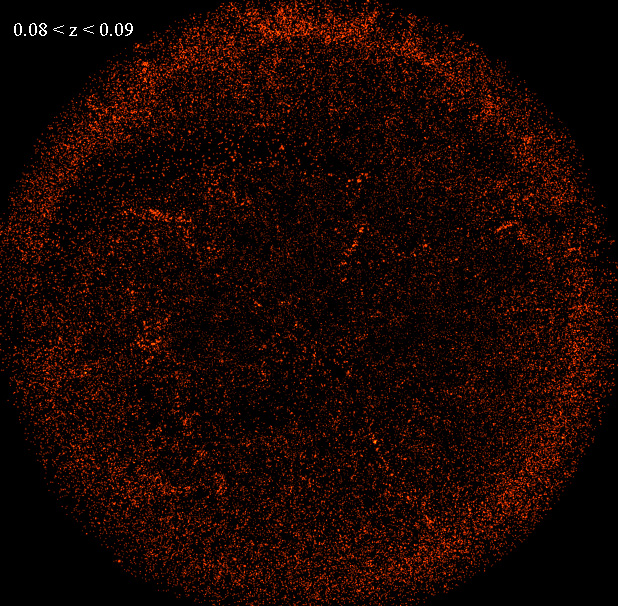
|
|
0.09 < z < 0.10 ; 27,000 to 30,000 km/s ; 351 to 388 Mpc The distribution looks smooth because of the uncertainties in the photometric redshifts render the structures less defined. Incompleteness is reducing the overall number of detections. The shell volume contains ~110,000 2MASS galaxies in 62 million Mpc3. |
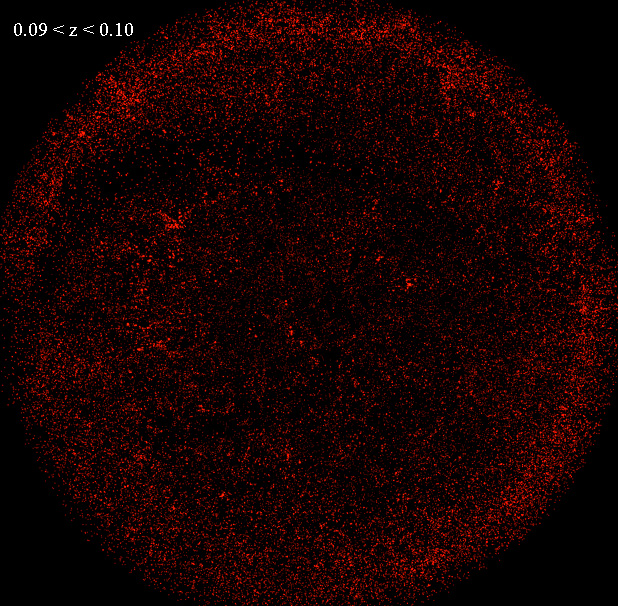
|
|
0.10 < z < 0.20 ; 30,000 to 60,000 km/s ; 388 to 726 Mpc The distribution looks smooth because of the uncertainties in the photometric redshifts render the structures less defined. Incompleteness is reducing the overall number of detections. The shell volume contains ~400,000 2MASS galaxies in ~1.4 billion Mpc3. |
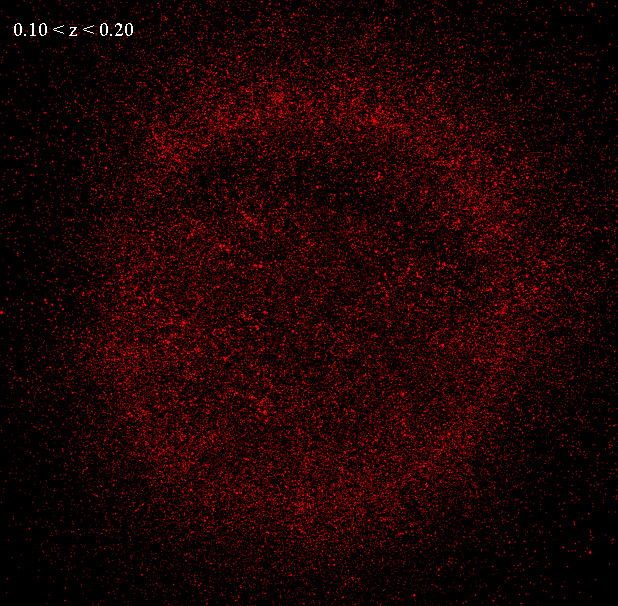
|
|
0 < z < 0.20 ; 0 to 60,000 km/s ; 0 to 726 Mpc The complete XSCz from 0 to 0.2 in redshift. Here is another view of the sphere, rotated so that the Milky Way "voids" are in clear projection. The spherical volume contains ~1.1 million 2MASS galaxies in ~1.6 billion Mpc3. |
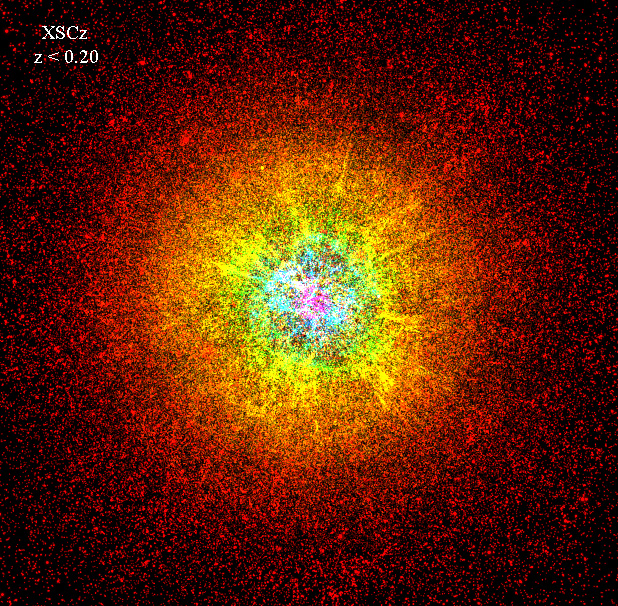
|

| main | Introduction | Summary Statistics | Spectroscopic Redshifts | Photometric Redshifts | Finger-of-God Artifacts | Visualization Partiview | Links References |